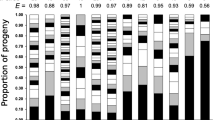Abstract.
In a variety of fish species with paternal care of offspring, females prefer to spawn in nests that already contain eggs. This female preference has been hypothesized to explain egg thievery in male sticklebacks, allopaternal care of eggs in minnows, and the evolution of egg-mimicking body features in male cichlids and darters. Here we employ microsatellite-based parentage analyses to evaluate the reproductive success of striped darter (Etheostoma virgatum) males that appear to utilize two of these functionally related tactics to entice females to spawn in their nests. In an isolated population (Clear Creek, Ky.), we observed that breeding males develop conspicuous white spots on their pectoral fins. If these spots are egg mimics, as we suspect, then this represents the fourth independent evolutionary origin of egg mimicry documented to date in darters, the first based on pigmentation (as opposed to physical structures), and the first in which the egg mimics vary greatly in number among males. From direct counts of microsatellite genotypes in clutches of embryos, at least 3.8 females contributed to the progeny within a typical nest, and females tended to spawn preferentially with males that were larger and displayed more egg-mimic spots. In another population (Hurricane Creek, Tenn.) without egg mimics, the multi-locus genetic data document that allopaternal care is common, especially among the smallest males who sometimes tend nests containing their own as well as an earlier sire's offspring. Thus, these foster males had adopted egg-containing nests and then successfully spawned with subsequent females. Overall, the genetic data on paternity and maternity, in conjunction with field observations, suggest that egg mimicry and allopaternal care are two mate-attracting reproductive tactics employed by striped darter males to exploit female preferences for spawning in nests with 'eggs'.
Similar content being viewed by others
Author information
Authors and Affiliations
Additional information
Electronic Publication
Rights and permissions
About this article
Cite this article
Porter, B.A., Fiumera, A.C. & Avise, J.C. Egg mimicry and allopaternal care: two mate-attracting tactics by which nesting striped darter (Etheostoma virgatum) males enhance reproductive success. Behav Ecol Sociobiol 51, 350–359 (2002). https://doi.org/10.1007/s00265-002-0456-4
Received:
Revised:
Accepted:
Issue Date:
DOI: https://doi.org/10.1007/s00265-002-0456-4




